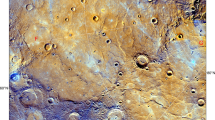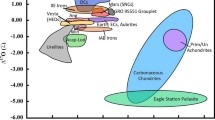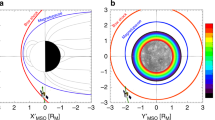Abstract
The instrument suite on the MErcury Surface, Space ENvironment, GEochemistry, and Ranging (MESSENGER) spacecraft is well suited to address several of Mercury’s outstanding geochemical problems. A combination of data from the Gamma-Ray and Neutron Spectrometer (GRNS) and X-Ray Spectrometer (XRS) instruments will yield the surface abundances of both volatile (K) and refractory (Al, Ca, and Th) elements, which will test the three competing hypotheses for the origin of Mercury’s high bulk metal fraction: aerodynamic drag in the early solar nebula, preferential vaporization of silicates, or giant impact. These same elements, with the addition of Mg, Si, and Fe, will put significant constraints on geochemical processes that have formed the crust and produced any later volcanism. The Neutron Spectrometer sensor on the GRNS instrument will yield estimates of the amount of H in surface materials and may ascertain if the permanently shadowed polar craters have a significant excess of H due to water ice. A comparison of the FeO content of olivine and pyroxene determined by the Mercury Atmospheric and Surface Composition Spectrometer (MASCS) instrument with the total Fe determined through both GRNS and XRS will permit an estimate of the amount of Fe present in other forms, including metal and sulfides.
Similar content being viewed by others
References
G.B. Andrews et al., Space Sci. Rev. (2007, this issue). doi:10.1007/s11214-007-9272-5
W. Benz, W.L. Slattery, A.G.W. Cameron, Icarus 74, 516–528 (1988)
T.A. Bida, R.M. Killen, T.H. Morgan, Nature 404, 159–161 (2000)
D.T. Blewett, P.G. Lucey, B.R. Hawke, G.G. Ling, M.S. Robinson, Icarus 129, 217–231 (1997)
D.T. Blewett, B.R. Hawke, P.G. Lucey, Meteorit. Planet. Sci. 37, 1245–1254 (2002)
W.V. Boynton et al., Science 297, 81–85 (2002)
W.V. Boynton et al., Space Sci. Rev. 110, 37–83 (2004)
W.V. Boynton et al., J. Geophys. Res. 112 (2007, in press)
T.H. Burbine, L.R. Nittler, G.K. Benedix, E.A. Cloutis, T.L. Dickinson, Meteorit. Planet. Sci. 37, 1233–1244 (2002)
B.J. Butler, J. Geophys. Res. 102, 19283–19291 (1997)
B.J. Butler, D.O. Muhleman, M.A. Slade, J. Geophys. Res. 98, 15003–15023 (1993)
A.G.W. Cameron, Icarus 64, 285–294 (1985)
B.A. Campbell, D.B. Campbell, J.F. Chandler, A.A. Hine, M.C. Nolan, P.J. Perillat, Nature 426, 137–138 (2003)
B. Cooper, A. Potter, R. Killen, T. Morgan, J. Geophys. Res. 106, 32803–32814 (2001)
D.H. Crider, R.M. Killen, Geophys. Res. Lett. 32, L12201 (2005). doi:10.1029/2005GL022689
D.L. Domingue et al., Space Sci. Rev. (2007, this issue). 10.1007/s11214-007-9260-9
L. Dones, B. Gladman, H.J. Melosh, W.B. Tonks, H.F. Levison, M. Duncan, Icarus 142, 509–524 (1999)
R.C. Elphic et al., J. Geophys. Res. 105, 20333–20345 (2000)
J.P. Emery, A.L. Sprague, F.C. Witteborn, J.E. Colwell, R.W.H. Kozlowski, D.H. Wooden, Icarus 136, 104–123 (1998)
B. Fegley Jr., A.G.W. Cameron, Earth Planet. Sci. Lett. 82, 207–222 (1987)
W.C. Feldman, B.L. Barraclough, C.J. Hansen, A.L. Sprague, J. Geophys. Res. 102, 25,565–25,574 (1997)
W.C. Feldman et al., Science 281, 1489–1493 (1998)
W.C. Feldman, D.J. Lawrence, R.C. Elphic, D.T. Vaniman, D.R. Thomsen, B.L. Barraclough, J. Geophys. Res. 105, 20347–20363 (2000a)
W.C. Feldman et al., J. Geophys. Res. 105, 4175–4195 (2000b)
W.C. Feldman et al., J. Geophys. Res. 107, 5016 (2002). doi:10.1029/2001JE001506
W.C. Feldman et al., J. Geophys. Res. 109, E07S06 (2004a). doi:10.1029/2003JE002207
W.C. Feldman et al., J. Geophys. Res. 109, E09006 (2004b). doi:10.1029/2003JE002160
W.C. Feldman et al., J. Geophys. Res. 110, E11009 (2005). doi:10.1029/2005JE002452
B.J. Gladman, J.A. Burns, M. Duncan, P. Lee, H.S. Levison, Science 271, 1387–1392 (1996)
R.E. Gold et al., Planet. Space Sci. 49, 1467–1479 (2001)
R.M. Goldstein, Science 168, 467–468 (1970)
J.O. Goldsten et al., Space Sci. Rev. (2007, this issue). doi:10.1007/s11214-007-9262-7
B. Hapke, J. Geophys. Res. 106, 10039–10073 (2001)
J.K. Harmon, Adv. Space Res. 19, 1487–1496 (1997)
J.K. Harmon, M.A. Slade, Science 258, 640–642 (1992)
J.K. Harmon, M.A. Slade, R.A. Velez, A. Crespo, M.J. Dryer, J.M. Johnson, Nature 369, 213–215 (1994)
J.K. Harmon, P.J. Perillat, M.A. Slade, Icarus 149, 1–15 (2001)
J.K. Harmon, M.A. Slade, B.J. Butler, J.W. Head III, M.S. Rice, D.B. Campbell, Icarus 187, 374–405 (2007)
S.E. Hawkins III, et al., Space Sci. Rev. (2007, this issue). doi:10.1007/s11214-007-9266-3
G.R. Hunt, R.K. Vincent, J. Geophys. Res. 73, 6039–6046 (1968)
D.M. Hunten, T.H. Morgan, D. Shemansky, in Mercury, ed. by F. Vilas, C.R. Chapman, M.S. Matthews (University of Arizona Press, Tucson, 1988), pp. 562–612
A.P. Ingersoll, T. Svitek, B.C. Murray, Icarus 100, 40–47 (1992)
A.J. Irving, et al., Eos Trans. Am. Geophys. Union 86 (Fall Meeting suppl.), F1198–F1199 (2005)
R. Jeanloz, D.L. Mitchell, A.L. Sprague, I. de Pater, Science 268, 1455–1457 (1995)
E. Kallio, P. Janhunen, Geophys. Res. Lett. 30, 1877 (2003). doi:10.1029/2003GL017842
R.M. Killen, J. Benkhoff, T.H. Morgan, Icarus 125, 195–211 (1997)
P.L. Koehn, A.L. Sprague, Planet. Space Sci. 55, 1530–1540 (2007)
J.S. Lewis, in Mercury, ed. by F. Vilas, C.R. Chapman, M.S. Matthews (University of Arizona Press, Tucson, 1988), pp. 651–667
L.M. Logan, G.R. Hunt, J. Geophys. Res. 75, 6539–6548 (1970)
S.G. Love, K. Keil, Meteorit. Planet. Sci. 30, 269–278 (1995)
B.G. Marsden, Annu. Rev. Astron. Astrophys. 43, 75–102 (2005)
S. Maurice, D.J. Lawrence, W.C. Feldman, R.C. Elphic, O. Gasnault, J. Geophys. Res. 109, E07S04 (2004). doi:10.1029/2003JE002208
W. McClintock, M.R. Lankton, Space Sci. Rev. (2007, this issue). doi:10.1007/s11214-007-9264-5
T.B. McCord, R.N. Clark, J. Geophys. Res. 84, 7664–7668 (1979)
H.J. Melosh, W.B. Tonks, Meteoritis 28, 398 (1993)
D.L. Mitchell, I. de Pater, Icarus 110, 2–32 (1994)
D.W. Mittlefehldt, M. Killgore, M.T. Lee, Meteorit. Planet. Sci. 37, 345–369 (2002)
D. Mitrofanov et al., Science 297, 78–81 (2002)
J.I. Moses, K. Rawlins, K. Zahnle, L. Dones, Icarus 137, 197–221 (1999)
S.K. Noble, C.M. Pieters, Sol. Syst. Res. 37, 34–39 (2003)
S.K. Noble et al., Meteorit. Planet. Sci. 36, 31–42 (2001)
D.A. Paige, S.E. Wood, A.R. Vasavada, Science 258, 643–646 (1992)
A.E. Potter, Geophys. Res. Lett. 22, 3289–3292 (1995)
A.E. Potter, T.H. Morgan, Science 248, 835–838 (1990)
A.E. Potter, T.H. Morgan, Planet. Space Sci. 45, 95–100 (1997)
T.H. Prettyman et al., J. Geophys. Res. 109, E05001 (2004). doi:10.1029/2003JE002139
M.S. Robinson, P.G. Lucey, Science 275, 197–200 (1997)
M.S. Robinson, G.J. Taylor, Meteorit. Planet. Sci. 36, 841–847 (2001)
J.W. Salisbury, B. Hapke, J.W. Eastes, J. Geophys. Res. 92, 702–710 (1987)
J.W. Salisbury, L.S. Walter, N. Vergo, D.M. D’Aria, Infrared (2.1–25 μ m) Spectra of Minerals (Johns Hopkins University Press, Baltimore, 1991), 267 pp
J.R. Salvail, F.P. Fanale, Icarus 111, 441–455 (1994)
A.G. Santo et al., Planet. Space Sci. 49, 1481–1500 (2001)
S. Sasaki, E. Kurahashi, Adv. Space Res. 33, 2152–2155 (2004)
C.E. Schlemm et al., Space Sci. Rev. (2007, this issue). doi:10.1007/s11214-007-9248-5
M.A. Slade, B.J. Butler, D.O. Muhleman, Science 258, 635–640 (1992)
S.C. Solomon et al., Planet. Space Sci. 49, 1445–1465 (2001)
A.L. Sprague, T.L. Roush, Icarus 133, 174–183 (1998)
A.L. Sprague, R.W.H. Kozlowski, D.M. Hunten, Science 249, 1140–1143 (1990)
A.L. Sprague, R.W.H. Kozlowski, F.C. Witteborn, D.P. Cruikshank, D.H. Wooden, Icarus 109, 156–167 (1994)
A.L. Sprague, D.M. Hunten, K. Lodders, Icarus 118, 211–215 (1995)
A.L. Sprague et al., Icarus 129, 506–527 (1997)
A.L. Sprague, W.J. Schmitt, R.E. Hill, Icarus 135, 60–68 (1998)
A.L. Sprague, J.P. Emery, K.L. Donaldson, R.W. Russell, D.K. Lynch, A.L. Mazuk, Meteorit. Planet. Sci. 37, 1255–1268 (2002)
P.D. Spudis, J.E. Guest, in Mercury, ed. by F. Vilas, C.R. Chapman, M.S. Matthews (University of Arizona Press, Tucson, 1988), pp. 118–164
L.V. Starukhina, J. Geophys. Res. 106, 14701–14710 (2001)
R.G. Strom, A.L. Sprague, Exploring Mercury the Iron Planet (Springer-Praxis, Chichester, 2003), 216 pp
G.J. Taylor et al., J. Geophys. Res. 111, E03S06 (2006). doi:10.1029/2006JE002676
R.L. Tokar et al., Geophys. Res. Lett. 29, 1904 (2002). doi:10.1029/2002GL015691
A.R. Vasavada, D.A. Paige, S.E. Wood, Icarus 141, 179–193 (1999)
F. Vilas, Icarus 64, 133–138 (1985)
F. Vilas, in Mercury, ed. by F. Vilas, C.R. Chapman, M.S. Matthews (University of Arizona Press, Tucson, 1988), pp. 59–76
F. Vilas, M.A. Leake, W.W. Mendell, Icarus 59, 60–68 (1984)
J. Wagner, B. Hapke, E. Wells, Icarus 69, 14–28 (1987)
J. Warell, Icarus 156, 303–317 (2002)
J. Warell, Icarus 161, 199–222 (2003)
J. Warell, D.T. Blewett, Icarus 168, 257–276 (2004)
J. Warell, A.L. Sprague, J.P. Emery, R.W.H. Kozlowski, A. Long, Icarus 180, 281–291 (2006)
T.R. Watters, F. Nimmo, M.S. Robinson, Geology 33, 669–672 (2005)
S.J. Weidenschilling, Icarus 35, 99–111 (1978)
G.W. Wetherill, in Mercury, ed. by F. Vilas, C.R. Chapman, M.S. Matthews (University of Arizona Press, Tucson, 1988), pp. 670–691
T.H. Zurbuchen, P. Koehn, L.A. Fisk, T. Gombosi, G. Gloeckler, K. Kabin, Adv. Space Res. 33, 1884–1889 (2004)
Author information
Authors and Affiliations
Corresponding author
Rights and permissions
About this article
Cite this article
Boynton, W.V., Sprague, A.L., Solomon, S.C. et al. MESSENGER and the Chemistry of Mercury’s Surface. Space Sci Rev 131, 85–104 (2007). https://doi.org/10.1007/s11214-007-9258-3
Received:
Accepted:
Published:
Issue Date:
DOI: https://doi.org/10.1007/s11214-007-9258-3




